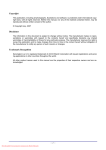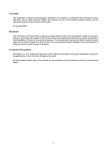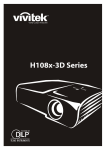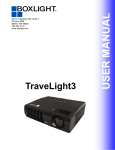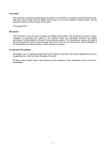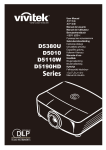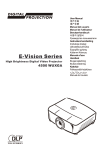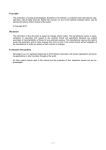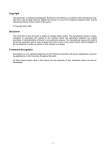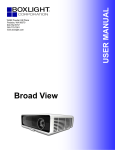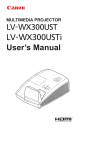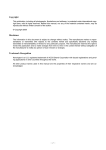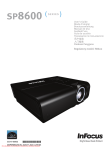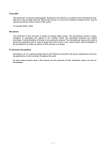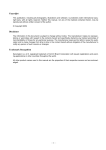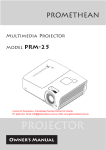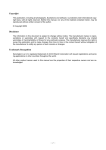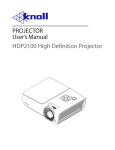Download Users Manual - Knoll Systems
Transcript
HDP2100 MK II DLP™ Projector Users Manual v1.0 D9 Series Copyright This publication, including all photographs, illustrations and software, is protected under international copyright laws, with all rights reserved. Neither this manual, nor any of the material contained herein, may be reproduced without written consent of the author. © Copyright 2012 Disclaimer The information in this document is subject to change without notice. The manufacturer makes no representations or warranties with respect to the contents hereof and specifically disclaims any implied warranties of merchantability or fitness for any particular purpose. The manufacturer reserves the right to revise this publication and to make changes from time to time in the content hereof without obligation of the manufacturer to notify any person of such revision or changes. Trademark Recognition Kensington is a U.S. registered trademark of ACCO Brand Corporation with issued registrations and pending applications in other countries throughout the world. HDMI, the HDMI Logo, and High-Definition Multimedia Interface are trademarks or registered trademarks of HDMI Licensing LLC in the United States and other countries. All other product names used in this manual are the properties of their respective owners and are acknowledged. —i— D DLLPP PPrroojjeeccttoorr— —U Usseerr’’ss M Maannuuaall Important Safety Information Important: It is strongly recommended that you read this section carefully before using the projector. These safety and usage instructions will ensure that you enjoy many years of safe use of the projector. Keep this manual for future reference. Symbols Used Warning symbols are used on the unit and in this manual to alert you of hazardous situations. The following styles are used in this manual to alert you to important information. Note: Provides additional information on the topic at hand. Important: Provides additional information that should not be overlooked. Caution: Alerts you to situations that may damage the unit. Warning: Alerts you to situations that may damage the unit, create a hazardous environment, or cause personal injury. Throughout this manual, component parts and items in the OSD menus are denoted in bold font as in this example: “Push the MENU button on the remote control to open the DISPLAY menu.” General Safety Information Do not open the unit case. Aside from the projection lamp, there are no user-serviceable parts in the unit. For servicing, contact qualified service personnel. Follow all warnings and cautions in this manual and on the unit case. The projection lamp is extremely bright by design. To avoid damage to eyes, do not look into the lens when the lamp is on. Do not place the unit on an unstable surface, cart, or stand. Avoid using the system near water, in direct sunlight, or near a heating device. Do not place heavy objects such as books or bags on the unit. — ii — PPrreeffaaccee Projector Installation Notice Place the projector in a horizontal position The tilt angle of the projector should not exceed 15 degrees, nor should the projector be installed in any way other than the desktop and ceiling mount, otherwise lamp life could decrease dramatically. Allow at least 50 cm clearance around the exhaust vent. Ensure that the intake vents do not recycle hot air from the exhaust vent. When operating the projector in an enclosed space, ensure that the surrounding air temperature within the enclosure does not exceed 5 – 35°C while the projector is running, and the air intake and exhaust vents are unobstructed. All enclosures should pass a certified thermal evaluation to ensure that the projector does not recycle exhaust air, as this may cause the device to shutdown even if the enclosure temperature is with the acceptable 5 – 35°C range. Power Safety Only use the supplied power cord. Do not place anything on the power cord. Place the power cord where it will not be in the way of foot traffic. Remove the batteries from the remote control when storing or not in use for a prolonged period. – iii – D DLLPP PPrroojjeeccttoorr— —U Usseerr’’ss M Maannuuaall Replacing the Lamp Replacing the lamp can be hazardous if done incorrectly. See Replacing the Projection Lamp on page 37 for clear and safe instructions for this procedure. Before replacing the lamp: Unplug the power cord. Allow the lamp to cool for about one hour. Caution: In rare cases the lamp bulb may burn out during normal operation and cause glass dust or shards to be discharged outward from the rear exhaust vent. Do not inhale or do not touch glass dust or shards. Doing so could result in injury. Always keep your face away from the exhaust vent so that you do not suffer from the gas and broken shards of the lamp. Cleaning the Projector Unplug the power cord before cleaning. See Cleaning the Projector on page 39. Allow the lamp to cool for about one hour. Regulatory Warnings Before installing and using the projector, read the regulatory notices in the Regulatory Compliance section on page 51. Important Recycle Instructions: Lamp(s) inside this product contain mercury. This product may contain other electronic waste that can be hazardous if not disposed of properly. Recycle or dispose in accordance with local, state, or federal Laws. For more information, contact the Electronic Industries Alliance at WWW.EIAE.ORG. For lamp specific disposal information check WWW.LAMPRECYCLE.ORG. Symbol Explanations DISPOSAL: Do not use household or municipal waste collection services for disposal of electrical and electronic equipment. EU countries require the use of separate recycling collection services. — iv — PPrreeffaaccee Table of Contents GETTING STARTED .......................................................................................................................................................... 1 PACKING CHECKLIST ........................................................................................................................................................... 1 VIEWS OF PROJECTOR PARTS ............................................................................................................................................... 2 Front-right View ............................................................................................................................................................. 2 Top view—On-screen Display (OSD) buttons and LEDs ............................................................................................... 3 Rear view ........................................................................................................................................................................ 4 Bottom view..................................................................................................................................................................... 5 REMOTE CONTROL PARTS ................................................................................................................................................... 6 REMOTE CONTROL OPERATING RANGE ............................................................................................................................... 8 PROJECTOR AND REMOTE CONTROL BUTTONS .................................................................................................................... 8 SETUP AND OPERATION ................................................................................................................................................. 9 INSERTING THE REMOTE CONTROL BATTERIES ................................................................................................................... 9 CONNECTING INPUT DEVICES ............................................................................................................................................ 10 STARTING AND SHUTTING DOWN THE PROJECTOR ............................................................................................................. 11 ADJUSTING THE PROJECTOR LEVEL ................................................................................................................................... 13 ADJUSTING THE ZOOM RING, FOCUS AND KEYSTONE ........................................................................................................ 14 ADJUSTING THE VOLUME .................................................................................................................................................. 15 ON-SCREEN DISPLAY (OSD) MENU SETTINGS....................................................................................................... 16 OSD MENU CONTROLS ..................................................................................................................................................... 16 Navigating the OSD ...................................................................................................................................................... 16 SETTING THE OSD LANGUAGE .......................................................................................................................................... 17 OSD MENU OVERVIEW ..................................................................................................................................................... 18 PICTURE>>BASIC MENU................................................................................................................................................. 19 PICTURE>>ADVANCED MENU ........................................................................................................................................ 20 HSG Adjustment............................................................................................................................................................ 21 DISPLAY MENU ............................................................................................................................................................... 22 PC Detail Adjustment.................................................................................................................................................... 23 SETUP>>BASIC MENU ..................................................................................................................................................... 24 Menu Settings................................................................................................................................................................ 25 Source ........................................................................................................................................................................... 25 Lan Control Settings ..................................................................................................................................................... 26 SETUP>>ADVANCED MENU ............................................................................................................................................ 32 Audio ............................................................................................................................................................................. 33 Lamp ............................................................................................................................................................................. 33 HDMI ............................................................................................................................................................................ 34 Closed Caption.............................................................................................................................................................. 34 Presentation Timer........................................................................................................................................................ 35 STATUS MENU ................................................................................................................................................................ 36 MAINTENANCE AND SECURITY................................................................................................................................. 37 REPLACING THE PROJECTION LAMP ................................................................................................................................... 37 CLEANING THE PROJECTOR ................................................................................................................................................ 39 Cleaning the Lens ......................................................................................................................................................... 39 Cleaning the Case ......................................................................................................................................................... 39 USING THE KENSINGTON® LOCK ....................................................................................................................................... 40 TROUBLESHOOTING ..................................................................................................................................................... 41 COMMON PROBLEMS AND SOLUTIONS ............................................................................................................................... 41 TIPS FOR TROUBLESHOOTING ............................................................................................................................................ 41 LED ERROR MESSAGES .................................................................................................................................................... 42 IMAGE PROBLEMS .............................................................................................................................................................. 42 LAMP PROBLEMS ............................................................................................................................................................... 43 REMOTE CONTROL PROBLEMS .......................................................................................................................................... 43 AUDIO PROBLEMS ............................................................................................................................................................. 44 HAVING THE PROJECTOR SERVICED .................................................................................................................................. 44 HDMI Q & A .................................................................................................................................................................... 45 –v– D DLLPP PPrroojjeeccttoorr— —U Usseerr’’ss M Maannuuaall SPECIFICATIONS............................................................................................................................................................. 46 SPECIFICATIONS ................................................................................................................................................................. 46 PROJECTION DISTANCE VS. PROJECTION SIZE ................................................................................................................... 47 Projection Distance and Size Table .............................................................................................................................. 47 TIMING MODE TABLE ........................................................................................................................................................ 48 PROJECTOR DIMENSIONS ................................................................................................................................................... 50 REGULATORY COMPLIANCE ..................................................................................................................................... 51 FCC WARNING .................................................................................................................................................................. 51 CANADA ............................................................................................................................................................................ 51 SAFETY CERTIFICATIONS ................................................................................................................................................... 51 — vi — D DLLPP PPrroojjeeccttoorr –– U Usseerr’’ss M Maannuuaall GETTING STARTED Packing Checklist Carefully unpack the projector and check that the following items are included: DLP PROJECTOR REMOTE CONTROL (WITH TWO AAA BATTERIES) VGA CABLE CD-ROM (THIS USER’S MANUAL) POWER CORD WARRANTY CARD Contact your dealer immediately if any items are missing, appear damaged, or if the unit does not work. It is recommend that you keep the original packing material should you ever need to return the equipment for warranty service. Caution: Avoid using the projector in dusty environments. –1– D DLLPP PPrroojjeeccttoorr— —U Usseerr’’ss M Maannuuaall Views of Projector Parts Front-right View 1 ITEM 2 3 4 LABEL 56 7 DESCRIPTION 1. Height-adjuster button Push to release height adjuster 2. Height adjuster Adjusts level of projector 3. Lens Projection Lens 4. IR receiver Receive IR signal from remote control 5. Focus ring Focuses the projected image 6. Zoom ring Enlarges the projected image 7. Function keys See Top view—On-screen Display (OSD) buttons and LEDs. SEE PAGE: 13 6 14 3 Important: Ventilation openings on the projector allow for good air circulation, which keeps the projector lamp cool. Do not obstruct any of the ventilation openings. –2– D DLLPP PPrroojjeeccttoorr –– U Usseerr’’ss M Maannuuaall Top view—On-screen Display (OSD) buttons and LEDs ITEM 1. LABEL (Power button) DESCRIPTION Turns the projector On or Off. 2. BLANK Displays a blank screen and mutes audio 3. ◄ (Left cursor) / Volume- Navigates and changes settings in the OSD Quick Menu – For Volume 4. Enter Enter or confirm highlighted OSD menu item 5. MENU Opens and exits OSD menus 6. ▲ (Up cursor) / Keystone+ Navigates and changes settings in the OSD Quick Menu – For Keystone 7. AUTO Optimizes image size, position, and resolution 8. ► (Right cursor) / Volume+ Navigates and changes settings in the OSD 9. SOURCE Enter the Source menu 10. ▼ (Down cursor) / Keystone- Navigates and changes settings in the OSD 11. READY LED SEE PAGE: 11 16 12. TEMP LED Quick Menu – For Volume Quick Menu – For Keystone 16 10 16 Red Lamp is ready to be powered-on. Flashing Lamp is not ready (warming up/shutting down/cooling) (see LED Error Messages on page 42) Flashing Error code –3– D DLLPP PPrroojjeeccttoorr— —U Usseerr’’ss M Maannuuaall Rear view ITEM 1. LABEL AC IN 2. DESCRIPTION Connect the POWER CABLE (USB) SEE PAGE: 11 For servicing purpose only 3. COMPONENT IN Connect a component video enabled device 4. S-VIDEO IN Connect the S-VIDEO CABLE from a video device 5. VIDEO IN Connect the COMPOSITE CABLE from a video device 6. VGA OUT Connect the RGB CABLE to a display 7. VGA IN Connect the RGB CABLE from a computer 8. HDMI – 1 Connect the HDMI TM CABLE from a HDMI TM device 9. HDMI – 2 Connect the HDMI TM CABLE from a HDMITM device 10. DC 12V TRIGGER Connect the 12V OUT 11. Kensington Lock Secure to permanent object with a Kensington® Lock system 40 12. Speaker Outputs audio sound 10 13. IR receiver Receive IR signal from remote control 6 14. AUDIO IN (L and R) Connect the AUDIO CABLES from a audio device 15. AUDIO IN Connect an AUDIO CABLE from the input device 16. RS-232C Connect RS-232 serial port cable for remote control 17. AUDIO OUT Connect an AUDIO CABLE for audio loop through 18. RJ – 45 Connect a LAN CABLE from Ethernet 10 10 Note: If your video equipment has various input sources, it is recommended to connect in priority of HDMI TM, component, S-Video, Composite for better picture quality. –4– D DLLPP PPrroojjeeccttoorr –– U Usseerr’’ss M Maannuuaall Bottom view ITEM LABEL DESCRIPTION SEE PAGE: 1. Tilt adjustor Rotate adjuster lever to adjust angle position. 2. Ceiling support holes Contact your dealer for information on mounting the projector on a ceiling 3. Height adjustor Adjuster drops down when adjuster button is pushed. 4. Height adjustor button Push to release adjustor. 13 13 Note: When installing, ensure that you use only UL Listed ceiling mounts. For ceiling installations, use approved mounting hardware and M4 screws with a maximum screw depth of 6 mm (0.23 inch). The construction of the ceiling mount must be of a suitable shape and strength. The ceiling mount load capacity must exceed the weight of the installed equipment, and as an additional precaution be capable of withstanding three times the weight of the equipment (not less than 5.15 kg) over a period of 60 seconds. –5– D DLLPP PPrroojjeeccttoorr— —U Usseerr’’ss M Maannuuaall Remote Control Parts Important: 1. Avoid using the projector with bright fluorescent lighting turned on. Certain high-frequency fluorescent lights can disrupt remote control operation. 2. Be sure nothing obstructs the path between the remote control and the projector. If the path between the remote control and the projector is obstructed, you can bounce the signal off certain reflective surfaces such as projector screens. 3. The buttons and keys on the projector have the same functions as the corresponding buttons on the remote control. This user’s manual describes the functions based on the remote control. –6– D DLLPP PPrroojjeeccttoorr –– U Usseerr’’ss M Maannuuaall ITEM LABEL DESCRIPTION SEE PAGE: 1. IR transmitter Transmits signals to projector 2. Status LED Lights when the remote control is used 3. Laser Press to operate the on-screen pointer 4. Up Up arrow when connected through USB to a PC (Not available in this series) 5. Right Right arrow when connected through USB to a PC (Not available in this series) 6. Down Down arrow when connected through USB to a PC (Not available in this series) 7. Page Down Page down when connected through USB to a PC (Not available in this series) 8. Up cursor 9. Right cursor 10. Down cursor 11. Navigates and changes settings in the OSD 16 Volume +/- Adjusts volume 15 12. Mute Mutes the built-in speaker 13. Zoom+ Zoom in 14. Zoom- Zoom out 15. Freeze Freeze/unfreezes the on-screen picture 16. Blank Makes the screen blank 17. Source Detects the input device 18. Auto Auto adjustment for phase, tracking, size, position 19. Menu Opens the OSD 16 20. Status Opens the OSD Status menu (the menu only opens when an input device is detected) 36 21. Keystone top/bottom Corrects image-trapezoid (wider top/bottom) effect 14 22. Left cursor Navigates and changes settings in the OSD 23. Enter Changes settings in the OSD 24. Page Up Page up when connected through USB to a PC (Not available in this series) 25. Left Left arrow when connected through USB to a PC (Not available in this series) 26. Enter Enter key when connected through USB to a PC (Not available in this series) 27. Power Turns the projector on or off 28. Laser Use as on-screen pointer. DO NOT POINT IN EYES. –7– 16 11 D DLLPP PPrroojjeeccttoorr— —U Usseerr’’ss M Maannuuaall Remote Control Operating Range The remote control uses infrared transmission to control the projector. It is not necessary to point the remote directly at the projector. Provided you are not holding the remote perpendicular to the sides or the rear of the projector, the remote will function well within a radius of about 7 meters (23 feet) and 15 degrees above or below the projector level. If the projector does not respond to the remote control, move a little closer. Projector and Remote Control Buttons The projector can be operated using the remote control or the buttons on the top of the projector. All operations can be carried out with the remote control; however, the buttons on the projector are limited in use. –8– D DLLPP PPrroojjeeccttoorr –– U Usseerr’’ss M Maannuuaall SETUP AND OPERATION Inserting the Remote Control Batteries 1. 2. 3. Remove the battery compartment cover by sliding the cover in the direction of the arrow. Insert the battery with the positive side facing up. Replace the cover. Caution: 1. Only use AAA batteries (Alkaline batteries are recommended). 2. Dispose of used batteries according to local ordinance regulations. 3. Remove the batteries when not using the projector for prolonged periods. –9– D DLLPP PPrroojjeeccttoorr— —U Usseerr’’ss M Maannuuaall Connecting Input Devices A PC or notebook computer and video devices can be connected to the projector at the same time. Video devices include DVD, VCD, and VHS players, as well as movie camcorders and digital still cameras. Check the user manual of the connecting device to confirm it has the appropriate output connector. ITEM A LABEL AC IN B DESCRIPTION Connect the POWER CABLE (USB) For servicing purpose only C COMPONENT IN Connect a component video enabled device D S-VIDEO IN Connect the S-VIDEO CABLE from a video device E VIDEO IN Connect the COMPOSITE CABLE from a video device F VGA OUT Connect the RGB CABLE to a display G VGA IN Connect the RGB CABLE from a computer H HDMI – 1 Connect the HDMITM CABLE from a HDMITM device I HDMI – 2 Connect the HDMITM CABLE from a HDMITM device J DC 12V TRIGGER Connect the 12V OUT K AUDIO IN (L and R) Connect the AUDIO CABLES from a audio device L AUDIO IN Connect an AUDIO CABLE from the input device M RS-232C Connect RS-232 serial port cable for remote control N AUDIO OUT Connect an AUDIO CABLE for audio loop through O RJ – 45 Connect a LAN CABLE from Ethernet Warning: As a safety precaution, disconnect all power to the projector and connecting devices before making connections. – 10 – D DLLPP PPrroojjeeccttoorr –– U Usseerr’’ss M Maannuuaall Starting and Shutting down the Projector 1. 2. 3. Connect the power cord to the projector. Connect the other end to a wall outlet. The POWER LED will be on. Turn on the connected devices. Ensure the POWER LED displays a solid blue and not a flashing blue. Then press the POWER button to turn on the projector. The projector splash screen displays and connected devices are detected. 4. If more than one input device is connected, press the SOURCE button and use ▲▼ to scroll among devices. • PC: Analog RGB • HDMI 1/2: High Definition Multimedia Interface • Component: DVD input YCbCr / YPbPr. • S-Video: Super video (Y/C separated) • Video: Traditional composite video – 11 – D DLLPP PPrroojjeeccttoorr— —U Usseerr’’ss M Maannuuaall 5. When the POWER OFF window appears, press on the control panel or on the remote control. The projector turns off. Caution: Do not unplug the power cord until the READY LED stops flashing–indicating the projector has cooled down. – 12 – D DLLPP PPrroojjeeccttoorr –– U Usseerr’’ss M Maannuuaall Adjusting the Projector Level Take note of the following when setting up the projector: • The projector table or stand should be level and sturdy. • Position the projector so that it is perpendicular to the screen. • Remove the Back Foot Holder on the rear adjuster foot before adjusting the projection angle. • Ensure the cables are in a safe location. You could trip over them. 1. To raise the level of the projector, lift the projector [A] and press the height-adjuster button [B]. The height adjuster drops down [C]. 2. 3. To lower the level of the projector, press the height-adjuster button and push down on the top of the projector. To adjust the angle of the picture, turn the tilt-adjuster [D] right or left until the desired angle has been achieved. – 13 – D DLLPP PPrroojjeeccttoorr— —U Usseerr’’ss M Maannuuaall Adjusting the Zoom ring, Focus and Keystone 1. 2. 3. Use the Image-zoom control (on the projector only) to resize the projected image and screen size . Use the Image-focus control (on the projector only) to sharpen the projected image . Use the KEYSTONE buttons (on the projector or the remote control) to correct image-trapezoid (wider top or bottom) effect. Remote control and OSD panel 4. The keystone control appears on the display. – 14 – D DLLPP PPrroojjeeccttoorr –– U Usseerr’’ss M Maannuuaall Adjusting the Volume 1. 2. 3. Press the Volume +/buttons on the remote control. The volume control appears on the display. Press the Left or Right Cursor buttons on the keypad to adjust Volume +/-. Press the MUTE button to turn off the volume (This feature is available only on the remote). – 15 – D DLLPP PPrroojjeeccttoorr— —U Usseerr’’ss M Maannuuaall ON-SCREEN DISPLAY (OSD) MENU SETTINGS OSD Menu Controls The projector has an OSD that lets you make image adjustments and change various settings. Navigating the OSD You can use the remote control cursor buttons or the buttons on the top of the projector to navigate and make changes to the OSD. The following illustration shows the corresponding buttons on the projector. 1. To enter the OSD, press the MENU button. 2. There are six menus. Press the cursor ◄► button to move through the menus. 3. Press the cursor ▲▼ button to move up and down in a menu. 4. Press ◄► to change values for settings. 5. Press MENU to close the OSD or leave a sub menu. Note: Depending on the video source, not all items in the OSD are available. For example, the PC Detail Adjustment item in the PICTURE>>Basic menu can only be modified when connected to a PC. Items that are not available cannot be accessed and are grayed out. – 16 – D DLLPP PPrroojjeeccttoorr –– U Usseerr’’ss M Maannuuaall Setting the OSD Language Set the OSD language to your preference before continuing. 1. Press the MENU button. Press the cursor ◄► button to navigate to SETUP>>Basic. 2. Press the cursor ▲▼ button until Language is highlighted. 3. Press the cursor ◄► button until the language you want is selected. 4. Press the MENU button to close the OSD. – 17 – D DLLPP PPrroojjeeccttoorr— —U Usseerr’’ss M Maannuuaall OSD Menu Overview Use the following illustration to quickly find a setting or determine the range for a setting. – 18 – D DLLPP PPrroojjeeccttoorr –– U Usseerr’’ss M Maannuuaall PICTURE>>Basic Menu Press the MENU button to open the OSD menu. Press the cursor ◄► button to move to the PICTURE>>Basic menu. Press the cursor ▲▼ button to move up and down in the PICTURE>>Basic menu. Press ◄► to change values for settings. Note: Customizing the settings in PICTURE>>Basic menu is only available in User 1/ 2/ 3 mode. ITEM DESCRIPTION Display Mode Press the cursor ◄► buttons to set the Display Mode. (Range: Movie/ Bright/ Normal/ User 1/ User 2/ User 3) Notes: ISF Day/ISF Night is available when ISF Mode is on. Brightness Press the cursor ◄► buttons to adjust the display brightness. Contrast Press the cursor ◄► buttons to adjust the display contrast. Color Press the cursor ◄► buttons to adjust the video saturation. Notes: This function is only available when Component, Video or S-Video input source is selected. Tint Press the cursor ◄► buttons to adjust the video tint/hue. Notes: This function is only available when Component, Video or S-Video with NTSC system input source is selected. Sharpness Press the cursor ◄► buttons to adjust the display sharpness. Notes: This function is only available when Component, Video or S-Video input source is selected. Flesh Tone Press the cursor ◄► buttons to adjust the display flesh tone. Notes: This function is only available when Component, Video or S-Video input source is selected. Reset Picture Settings Press the ENTER button to reset all settings to default values. – 19 – D DLLPP PPrroojjeeccttoorr— —U Usseerr’’ss M Maannuuaall PICTURE>>Advanced Menu Press the MENU button to open the OSD menu. Press the cursor ◄► button to move to the PICTURE>>Advanced menu. Press the cursor ▲▼ button to move up and down in the PICTURE>>Advanced menu. Press ◄► to change values for settings. ITEM DESCRIPTION Noise Reduction Press the cursor ◄► button to adjust the Noise Reduction. Color Temperature Press the cursor ◄► button to set the Color Temperature. Gamma Press the cursor ◄► button to adjust the gamma correction of the display. Notes: This function is only available in User 1/ 2/ 3 mode. HSG Adjustment Press the ENTER button to enter the HSG Adjustment sub menu. See HSG Adjustment on page 21. Color Space Press the cursor ◄► button to set the Color Space. (Range: Auto/ RGB/ SDTV/ HDTV) Notes: This function is only available when HDMI TM input source is selected. – 20 – D DLLPP PPrroojjeeccttoorr –– U Usseerr’’ss M Maannuuaall HSG Adjustment Press the ENTER button to enter the HSG Adjustment sub menu. ITEM DESCRIPTION Primary Color Press the ◄► buttons to set the Primary Color. Notes: There are six sets (R/ G/ B/ C/ M/ Y) of colors to be customized. Hue Press the ◄► buttons to adjust the Hue. Saturation Press the ◄► buttons to adjust the Saturation. Gain Press the ◄► buttons to adjust the Gain. – 21 – D DLLPP PPrroojjeeccttoorr— —U Usseerr’’ss M Maannuuaall DISPLAY Menu Press the MENU button to open the OSD menu. Press the cursor ◄► button to move to the DISPLAY menu. Press the cursor ▲▼ button to move up and down in the DISPLAY menu. Press ◄► to change values for settings. ITEM DESCRIPTION Aspect Ratio Press the cursor ◄► button to set the Aspect Ratio. (Range: Auto/ 16:9/ 4:3/ Letter Box/ Real) Keystone Press the cursor ◄► button to adjust the Keystone. Notes: This function is available when the Auto keystone function is turned off. Overscan Press the cursor ◄► button to adjust the Overscan. PC Detail Adjustment Press the ENTER button to enter the PC Detail Adjustment sub menu. See PC Detail Adjustment on page 23. Auto Keystone Press the cursor ◄► button to turn on or off the Auto Keystone. Notes: When Auto Keystone is on, the projector will automatically adjust the Keystone. – 22 – D DLLPP PPrroojjeeccttoorr –– U Usseerr’’ss M Maannuuaall PC Detail Adjustment Press the ENTER button to enter the PC Detail Adjustment sub menu. Note: Customizing the settings in PC Detail Adjustment menu is only available when PC input source (analog RGB) is selected. ITEM DESCRIPTION Auto Press the ENTER/AUTO button on the control panel or the ENTER/AUTO button on the remote control to automatically adjust frequency, phase, and position. Frequency Press the ◄► buttons to adjust the A/D sampling number. Phase Press the ◄► buttons to adjust the A/D sampling clock. Horizontal Position Press the ◄► buttons to adjust the display position right or left. Vertical Position Press the ◄► buttons to adjust the display position up or down. – 23 – D DLLPP PPrroojjeeccttoorr— —U Usseerr’’ss M Maannuuaall SETUP>>Basic Menu Press the MENU button to open the OSD menu. Press the cursor ◄► button to move to the SETUP>>Basic menu. Press the cursor ▲▼ button to move up and down in the SETUP>>Basic menu. Press ◄► to change values for settings. ITEM DESCRIPTION Language Press the cursor ◄► buttons to select a different localization menu. (Range: English/ Danish/ Dutch/ Finnish/ French/ German/ Italian/ Japanese/ Korea/Norwegian/ Polish/ Portuguese/ Russian/ Traditional Chinese/ Simplified Chinese/ Spanish/ Swedish) Splash Logo Press the cursor ◄► buttons to select a different startup screen. (Range: Knoll/ Blue/ Black) Projection Press the cursor ◄► buttons to choose from four projection methods: Front Table/ Front Ceiling/ Rear Table/ Rear Ceiling. Blank Timer Press the cursor ◄► buttons to set the Blank Screen timer. The projected image is automatically restored after the set time. (Range: Disable/ 5 min/ 10 min/ 15 min/ 20 min/ 25 min/ 30 min) Auto Power Off Press the cursor ◄► buttons to set the Auto Power Off timer. The projector automatically turns off if no input source is detected after the preset period of time. (Range: Disable/ 5 min/ 10 min/ 15 min/ 20 min/ 25 min/ 30 min) Sleep Timer Press the cursor ◄► buttons to set Sleep timer. The projector automatically turns off after the preset period of time. (Range: Disable/ 30 min/ 1hr/ 2hr/ 3hr/ 4hr/ 8hr/ 12hr) Background Color Press the cursor ◄► buttons to select the background color when no input source is detected. (Range: Purple/ Black/ Blue) Menu Settings Press the ENTER button to enter the Menu Settings sub menu. See Menu Settings on page 25. Source Press the ENTER button to enter the Source sub menu. See Source on page 25. Lan Control Settings Press the ENTER button to enter the Lan Control Settings sub menu. See Lan Control Settings on page 26. – 24 – D DLLPP PPrroojjeeccttoorr –– U Usseerr’’ss M Maannuuaall Menu Settings Press the ENTER button to enter the Menu Settings sub menu. ITEM DESCRIPTION Menu Position Press the ◄► buttons to select from five OSD locations: Top-Left/ Top-Right/ Center/ Bottom-Left/ Bottom-Right. Menu Transparency Press the ◄► buttons to set the OSD transparency. (Range: 0 ~ 10) Menu Display Time Press the ◄► buttons to set the Menu Display timer before the OSD times out. (Range: 5sec/ 10sec/ 15sec/ 20sec/ 25sec/ 30sec) Source Press the ENTER button to enter the Source sub menu. ITEM PC HDMI 1 DESCRIPTION Press the ◄► buttons to enable or disable the PC source. Press the ◄► buttons to enable or disable the HDMI source. HDMI 2 Component Press the ◄► buttons to enable or disable the Component source. Video Press the ◄► buttons to enable or disable the Video source. S-Video Press the ◄► buttons to enable or disable the S-Video source. Quick Auto Search Press the ◄► buttons to enable or disable Quick Auto Search for available input source. Notes: When the desired source is selected, the Quick Auto Search function will be turn off. – 25 – D DLLPP PPrroojjeeccttoorr— —U Usseerr’’ss M Maannuuaall Lan Control Settings Press the ENTER button to enter the Lan Control Settings sub menu. ITEM DESCRIPTION Control By Press the ◄► buttons to select projector remote command control. (Range: RS232/ RJ45) Network State Press the ENTER button to enter the Network State sub menu. See Network State on page 26. Network State ITEM Network State DESCRIPTION Displays the network connection status. Press ◄► to turn DHCP On or Off. DHCP Note: If you select DHCP Off, complete the IP Address, Subnet Mask, Gateway, and DNS fields. Projector IP Address Enter a valid IP address if DHCP is turned off. Subnet Mask Enter a valid Subnet Mask if DHCP is turned off. Default Gateway Displays the default Gateway address on the network. DNS Enter a valid DNS name if DHCP is turned off. Apply Press (Enter) / ► to confirm settings. – 26 – D DLLPP PPrroojjeeccttoorr –– U Usseerr’’ss M Maannuuaall For simplicity and ease of operation, the projector provides diverse networking and remote management features. The LAN/RJ45 function of the projector through a network, such as remotely manage: Power On/Off, Brightness and Contrast settings. Also, projector status information, such as: Video-Source, SoundMute, etc. 1. Connect an RJ45 cable to RJ45 ports on the projector and the PC (Laptop). 2. On the PC (Laptop), select Start ´ Control Panel ´ Network Connections. – 27 – D DLLPP PPrroojjeeccttoorr— —U Usseerr’’ss M Maannuuaall 3. Right-click on Local Area Connection, and select Properties. 4. In the Properties window, select the General tab, and select Internet Protocol (TCP/IP). 5. Click Properties. – 28 – D DLLPP PPrroojjeeccttoorr –– U Usseerr’’ss M Maannuuaall 6. Click Use the following IP address and fill in the IP address and Subnet mask, then click OK. 7. Press the Menu button on the projector. 8. Select OSD ´ SETUP ´ Network ´ Enabled. 9. After getting into Network, input the following: ` DHCP: Off ` IP Address: 10. 10. 10. 10 ` Subnet Mask: 255.255.255.0 ` Gateway: 0.0.0.0 ` DNS Server: 0.0.0.0 10. Press (Enter) / ► to confirm settings. 11. Open a web browser (for example, Microsoft Internet Explorer with Adobe Flash Player 9.0 or higher). 12. In the Address bar, input the IP address: 10. 10. 10. 10. – 29 – D DLLPP PPrroojjeeccttoorr— —U Usseerr’’ss M Maannuuaall (Enter) / ►. 13. Press The projector is setup for remote management. The LAN/RJ45 function displays as follows. Based on network web-page for the input-string in tools tab, the limitation for Input-Length is in the below list (“space” and the other punctuation key included): CATEGORY Crestron Control Projector Network Configuration User Password Admin Password ITEM INPUT-LENGTH IP Address 15 IP ID 2 Port 5 Projector Name 10 Location 9 Assigned To 8 DHCP (Enabled) (N/A) IP Address 15 Subnet Mask 15 Default Gateway 15 DNS Server 15 Enabled (N/A) New Password 15 Confirm 15 Enabled (N/A) New Password 15 Confirm 15 – 30 – D DLLPP PPrroojjeeccttoorr –– U Usseerr’’ss M Maannuuaall For more information, please visit http://www.crestron.com/. – 31 – D DLLPP PPrroojjeeccttoorr— —U Usseerr’’ss M Maannuuaall SETUP>>Advanced Menu Press the MENU button to open the OSD menu. Press the cursor ◄► button to move to the SETUP>>Advanced menu. Press the cursor ▲▼ button to move up and down in the SETUP>>Advanced menu. ITEM Audio DESCRIPTION Press the ENTER button to enter the Audio sub menu. See Audio on page 33. Lamp Press the ENTER button to enter the Lamp sub menu. See Lamp on page 33. HDMI Press the ENTER button to enter the HDMI sub menu. See HDMI on page 34. High Altitude Mode Press the cursor ◄► buttons to turn on or off High Altitude Mode when the altitude of the environment is higher than 1500m, or the temperature is over 40°C. Test Pattern Press the cursor ◄► buttons to turn on or off the grid test pattern. Closed Caption Press the ENTER button to enter the Closed Caption sub menu. See Closed Caption on page 34. LED Control Press the cursor ◄► buttons to select the LED control. Select Normal for normal LED display and Off to disable LED display. Presentation Timer Press Reset All Press the ENTER button to enter reset all settings to default values. (Enter) / ► to the Presentation Timer menu. See Presentation Timer on page 35. – 32 – D DLLPP PPrroojjeeccttoorr –– U Usseerr’’ss M Maannuuaall Audio Press the ENTER button to enter the Audio sub menu. ITEM DESCRIPTION Volume Press the ◄► buttons to adjust the audio Volume. Bass Press the ◄► buttons to adjust the audio Bass. Treble Press the ◄► buttons to adjust the audio Treble. Mute Press the ◄► buttons to turn on or off the speaker. AGC Press the ◄► buttons to turn on or off the AGC setting. Reset Press the ENTER button to reset all settings to default values. Lamp Press the ENTER button to enter the Lamp sub menu. ITEM DESCRIPTION Lamp Mode Press the ◄► buttons to adjust lamp brightness. Reset Lamp Timer Press the ENTER button to reset the Lamp Hour after the lamp is replaced. Lamp Hour Displays the number of hours the lamp has been in use. – 33 – D DLLPP PPrroojjeeccttoorr— —U Usseerr’’ss M Maannuuaall HDMI Press the ENTER button to enter the HDMI sub menu. ITEM DESCRIPTION HDMI Format Press the ◄► buttons to select from three HDMI display formats: Auto/ PC signal/ Video signal. HDMI Amplifier Gain Press the ◄► buttons to adjust HDMI Amplifier Gain. Closed Caption Press the ENTER button to enter the Closed Caption sub menu. ITEM DESCRIPTION Closed Caption Enable Press the ◄► buttons to turn on or off Closed Caption. Caption Version Press the ◄► buttons to select the Caption Version. – 34 – D DLLPP PPrroojjeeccttoorr –– U Usseerr’’ss M Maannuuaall Presentation Timer The Presentation Timer function can indicate the presentation time on the screen to help you achieve better time management when giving presentations. ITEM DESCRIPTION Timer Press the cursor ◄► button to enable or disable presentation timer. Timer Period Press the cursor ◄► button to select timer period (1 ~ 60 minutes) Timer Reset Press (Enter) / ► to reset the timer settings. – 35 – D DLLPP PPrroojjeeccttoorr— —U Usseerr’’ss M Maannuuaall STATUS Menu Press the MENU button to open the OSD menu. Press the cursor ◄► button to move to the STATUS Menu. ITEM DESCRIPTION Source Displays the activated input source. Resolution Displays the native resolution of input source. Lamp Hour Displays the number of hours the lamp has been in use. Firmware Version Displays the firmware version of the projector. Note: Status displayed in this menu is for viewing only and cannot be edited. – 36 – D DLLPP PPrroojjeeccttoorr –– U Usseerr’’ss M Maannuuaall MAINTENANCE AND SECURITY Replacing the Projection Lamp The projection lamp should be replaced when it burns out. It should only be replaced with a certified replacement part, which you can order from your local dealer. Important: a. The projection lamp used in this product contains a small amount of mercury. b. Do not dispose this product with general household waste. c. Disposal of this product must be carried out in accordance with the regulations of your local authority. Warning: Be sure to turn off and unplug the projector at least 30 minutes before replacing the lamp. Failure to do so could result in a severe burn. Caution: In rare cases the lamp bulb may burn out during normal operation and cause glass dust or shards to be discharged outward from the rear exhaust vent. Do not inhale or do not touch glass dust or shards. Doing so could result in injury. Always keep your face away from the exhaust vent so that you do not suffer from the gas and broken shards of the lamp. When removing the lamp from a ceiling-mounted projector, make sure that no one is under the projector. Glass fragments could fall if the lamp has been burned out. ! IF A LAMP EXPLODES If a lamp explodes, the gas and broken shards may scatter inside the projector and they may come out of the exhaust vent. The gas contains toxic mercury. Open windows and doors for ventilation. If you inhale the gas or the shards of the broken lamp enter your eyes or mouth, consult the doctor immediately. 1. 2. Remove the single screw on the lamp compartment cover. Remove the lamp compartment cover. – 37 – D DLLPP PPrroojjeeccttoorr— —U Usseerr’’ss M Maannuuaall 3. Remove the three screws from the lamp module. 4. Lift the module handle up. 5. Pull firmly on the module handle to remove the lamp module. 6. Reverse steps 1 to 5 to install the new lamp module. While installing, align the lamp module with the connector and ensure it is level to avoid damage. Note: The lamp module must sit securely in place and the lamp connector must be connected properly before tightening the screws. – 38 – D DLLPP PPrroojjeeccttoorr –– U Usseerr’’ss M Maannuuaall Cleaning the Projector Cleaning the projector to remove dust and grime will help ensure trouble-free operation. Warning: 1. Be sure to turn off and unplug the projector at least 30 minutes before cleaning. Failure to do so could result in a severe burn. 2. Use only a dampened cloth when cleaning. Do not allow water to enter the ventilation openings on the projector. 3. If a little water gets into the projector interior while cleaning, leave unplugged in a well-ventilated room for several hours before using. 4. If a lot of water gets into the projector interior when cleaning, have the projector serviced. Cleaning the Lens You can purchase optic lens cleaner from most camera stores. Refer to the following to clean the projector lens. 1. Apply a little optic lens cleaner to a clean soft cloth. (Do not apply the cleaner directly to the lens.) 2. Lightly wipe the lens in a circular motion. Caution: 1. Do not use abrasive cleaners or solvents. 2. To prevent discoloration or fading, avoid getting cleaner on the projector case. Cleaning the Case Refer to the following to clean the projector case. 1. Wipe off dust with a clean dampened cloth. 2. Moisten the cloth with warm water and mild detergent (such as used to wash dishes), and then wipe the case. 3. Rinse all detergent from the cloth and wipe the projector again. Caution: To prevent discoloration or fading of the case, do not use abrasive alcohol-based cleaners. – 39 – D DLLPP PPrroojjeeccttoorr— —U Usseerr’’ss M Maannuuaall Using the Kensington® Lock If you are concerned about security, attach the projector to a permanent object with the Kensington slot and a security cable. Note: Contact your vendor for details on purchasing a suitable Kensington security cable. The security lock corresponds to Kensington’s MicroSaver Security System. If you have any comment, contact: Kensington, 2853 Campus Drive, San Mateo, CA 94403, U.S.A. Tel: 800-535-4242, http://www.Kensington.com. – 40 – D DLLPP PPrroojjeeccttoorr –– U Usseerr’’ss M Maannuuaall TROUBLESHOOTIN G Common problems and solutions These guidelines provide tips to deal with problems you may encounter while using the projector. If the problem remains unsolved, contact your dealer for assistance. Often after time spent troubleshooting, the problem is traced to something as simple as a loose connection. Check the following before proceeding to the problem-specific solutions. • Use some other electrical device to confirm that the electrical outlet is working. • Ensure the projector is turned on. • Ensure all connections are securely attached. • Ensure the attached device is turned on. • Ensure a connected PC is not in suspending mode. • Ensure a connected notebook computer is configured for an external display. (This is usually done by pressing a Fn-key combination on the notebook). Tips for Troubleshooting In each problem-specific section, try the steps in the order suggested. This may help you to solve the problem more quickly. Try to pin point the problem and thus avoid replacing non-defective parts. For example, if you replace batteries and the problem remains, put the original batteries back and go to the next step. Keep a record of the steps you take when troubleshooting: The information may be useful when calling for technical support or for passing on to service personnel. – 41 – D DLLPP PPrroojjeeccttoorr— —U Usseerr’’ss M Maannuuaall LED Error Messages POWER LED BLINK READY LED BLINK TEMP LED BLINK Lamp Ready ON ON OFF Start ON OFF OFF Cooling ON FLASHING OFF Over temperature OFF OFF ON Thermal Break Sensor error 4 4 OFF Lamp error 5 OFF OFF Lamp End of lamp life detected 5 3 OFF Burner Fan error 6 1 OFF Lamp Fan error 6 2 OFF Power Fan error 6 3 OFF DMD Fan error 6 4 OFF Case Open 7 OFF OFF DMD error 8 OFF OFF Color wheel error 9 OFF OFF ERROR CODE MESSAGES In the event of an error, please disconnect the AC power cord and wait for one (1) minute before restarting the projector. If the POWER or LAMP LEDs are still blinking or the TEMP LED is lit, or any other situation that isn't listed in the chart above, contact your service center. Image Problems Problem: No image appears on the screen 1. Verify the settings on your notebook or desktop PC. 2. Turn off all equipment and power up again in the correct order. Problem: The image is blurred 1. Adjust the Focus on the projector. 2. Press the Auto button on the remote control or projector. 3. Ensure the projector-to-screen distance is within the 10-meter (33-feet) specified range. 4. Check that the projector lens is clean. Problem: The image is wider at the top or bottom (trapezoid effect) 1. Position the projector so it is as perpendicular to the screen as possible. 2. Use the Keystone button on the remote control or projector to correct the problem. Problem: The image is reversed Check the Projection setting on the Installation I menu of the OSD. Problem: The image is streaked 1. Set the Frequency and Tracking settings on the Computer menu of the OSD to the default settings. 2. To ensure the problem is not caused by a connected PC’s video card, connect to another computer. – 42 – D DLLPP PPrroojjeeccttoorr –– U Usseerr’’ss M Maannuuaall Problem: The image is flat with no contrast Adjust the Contrast setting on the Image menu of the OSD. Problem: The color of the projected image does not match the source image. Adjust the Color Temperature and Gamma settings on the Image menu of the OSD. Lamp Problems Problem: There is no light from the projector 1. Check that the power cable is securely connected. 2. Ensure the power source is good by testing with another electrical device. 3. Restart the projector in the correct order and check that the Power LED is green. 4. If you have replaced the lamp recently, try resetting the lamp connections. 5. Replace the lamp module. 6. Put the old lamp back in the projector and have the projector serviced. Problem: The lamp goes off 1. Power surges can cause the lamp to turn off. Re-plug power cord. When the READY LED is on, press the power button. 2. Replace the lamp module. 3. Put the old lamp back in the projector and have the projector serviced. Remote Control Problems Problem: The projector does not respond to the remote control 1. Direct the remote control towards remote sensor on the projector. 2. Ensure the path between remote and sensor is not obstructed. 3. Turn off any fluorescent lights in the room. 4. Check the battery polarity. 5. Replace the batteries. 6. Turn off other Infrared-enabled devices in the vicinity. 7. Have the remote control serviced. – 43 – D DLLPP PPrroojjeeccttoorr— —U Usseerr’’ss M Maannuuaall Audio Problems Problem: There is no sound 1. Adjust the volume on the remote control. 2. Adjust the volume of the audio source. 3. Check the audio cable connection. 4. Test the source audio output with other speakers. 5. Have the projector serviced. Problem: The sound is distorted 1. Check the audio cable connection. 2. Test the source audio output with other speakers. 3. Have the projector serviced. Having the Projector Serviced If you are unable to solve the problem, you should have the projector serviced. Pack the projector in the original carton. Include a description of the problem and a checklist of the steps you took when trying to fix the problem: The information may be useful to service personnel. For servicing, return the projector to the place you purchased it. – 44 – D DLLPP PPrroojjeeccttoorr –– U Usseerr’’ss M Maannuuaall HDMI Q & A Q. What is the difference between a “Standard” HDMI cable and a “High-Speed” HDMI cable? Recently, HDMI Licensing, LLC announced that cables would be tested as Standard or HighSpeed cables. ․Standard (or “category 1”) HDMI cables have been tested to perform at speeds of 75Mhz or up to 2.25Gbps, which is the equivalent of a 720p/1080i signal. ․ High Speed (or “category 2”) HDMI cables have been tested to perform at speeds of 340Mhz or up to 10.2Gbps, which is the highest bandwidth currently available over an HDMI cable and can successfully handle 1080p signals including those at increased color depths and/or increased refresh rates from the Source. High-Speed cables are also able to accommodate higher resolution displays, such as WQXGA cinema monitors (resolution of 2560 x 1600). Q. How do I run HDMI cables longer than 10 meters? To extend a cable’s effective distance from the typical 10 meter range a Knoll balun system may be required. See your dealer for more information. Some baluns can extend the signal up to 200 meters. Q. How can I tell if a cable is an HDMI certified cable? All HDMI products are required to be certified by the manufacturer as part of the HDMI Compliance Test Specification. However, there may be instances where cables bearing the HDMI logo are available but have not been properly tested. HDMI Licensing, LLC actively investigates these instances to ensure that the HDMI trademark is properly used in the market. We recommend that consumers buy their cables from a reputable source and a company that is trusted. For more detail information check http://www.hdmi.org/learningcenter/faq.aspx#49 – 45 – D DLLPP PPrroojjeeccttoorr— —U Usseerr’’ss M Maannuuaall SPECIFICATIONS Specifications Model HDP2100 MK II TI DLP DMD 0.65” Display type 1920 x 1080 Native Resolution 3.4 kg (7.5 lbs) Weight 1 meters ~ 10 meters Projection distance 23.5" ~ 282.3" Projection screen size Manual Focus/Manual Zoom Projection lens 1.2 Zoom ratio +/- 30 steps Vertical keystone correction +/- 40 steps Yes Auto Keystone Projection methods Front, Rear, Desktop/Ceiling (Rear, Front) Data compatibility VGA, SVGA, XGA, SXGA, UXGA, Mac SDTV/ EDTV/ HDTV 480i, 480p,576i, 576p, 720p, 1080i, 1080p NTSC 4.43, PAL (M/N/60), SECAM Video compatibility H-Sync 15K, 31 – 91.1 KHz V-Sync 43 – 85 Hz Safety certification FCC-B, UL, cUL, CB, CE, CCC, KC, PCT, and C-tick Operation temperature 5° ~ 35°C Dimensions (W x D x H) 332.8 mm x 254.6 mm x 113 mm (13.1” x 10.0” x 4.45”) AC Input Power consumption AC Universal 100-240, Typical @ 110VAC (100-240)/ ± 10% STD: 290W(Typical)/ STD: 350W(Typical)/ STD: 350W(Typical)/ 310W(Max) 370W(Max) 380W(Max) ECO: 240W(Typical)/ ECO: 290W(Typical)/ ECO: 290W(Typical)/ 260W(Max) 310W(Max) 320W(Max) <1 watt Stand By Lamp 220W 280W 300W AMP 5W speaker Audio speaker Digital: HDMI x 2 Analog: RGB HD-15 x 1 Composite: RCA x 1 (Yellow) Input Terminals S-Video: mini dim x 1 Component: RCA x 3 Audio in: ψ3.5 mm stereo mini jack x 1; RCA x 2 R/L Analog: RGB HD-15 x 1 Output Terminals Mini-jack stereo x 1 DC_out (screen trigger): DC Jack x 1 (DC12V 200mA output function) RS-232: DSUB-9 x 1 Control Terminals Keyboard Emulation Control: USB connector type B RJ45 Kensington lock Security – 46 – D DLLPP PPrroojjeeccttoorr –– U Usseerr’’ss M Maannuuaall Image Height Projection Distance vs. Projection Size Projection Distance and Size Table HDP2100 MKII (16 x 9 SCREEN) IMAGE DIAGONAL (INCH) IMAGE WIDTH (INCH) PROJECTION DISTANCE (MM) FROM IMAGE HEIGHT (INCH) PROJECTION DISTANCE (MM) TO OFFSET-A ( MM ) 40 34.9 19.6 1408.0 1682.5 74.7 60 52.3 29.4 2112.0 2523.7 112.1 70 61 34.3 2464.0 2944.4 130.8 72 62.8 35.3 2534.4 3028.5 134.5 80 69.7 39.2 2816.0 3365.0 149.4 84 73.2 41.2 2956.8 3533.2 156.9 90 78.4 44.1 3168.0 3785.6 168.1 96 83.7 47.1 3379.1 4038.0 179.3 100 87.2 49.0 3519.9 4206.2 186.8 120 104.6 58.8 4223.9 5047.5 224.1 135 117.7 66.2 4751.9 5678.4 252.2 150 130.7 73.5 5279.9 6309.3 280.2 200 174.3 98.1 7039.9 8412.4 373.6 300 261.5 147.1 10559.8 12618.7 560.4 – 47 – D DLLPP PPrroojjeeccttoorr— —U Usseerr’’ss M Maannuuaall Timing Mode Table The projector can display several resolutions. The following table outlines the resolutions that can be displayed by the projector. RESOLUTION H-SYNC (KHZ) NTSC — 15.734 60.0 O — - - PAL/SECAM — 15.625 50.0 O — - - 720 x 400 37.9 85.0 — — O O 640 x 480 31.5 60.0 — — O O 640 x 480 37.9 72.8 — — O O 640 x 480 37.5 75.0 — — O O 640 x 480 43.3 85.0 — — O O 800 x 600 35.2 56.3 — — O O 800 x 600 37.9 60.3 — — O O 800 x 600 46.9 75.0 — — O O 800 x 600 48.1 72.2 — — O O 800 x 600 53.7 85.1 — — O O 1024 x 768 48.4 60.0 — — O O 1024 x 768 56.5 70.1 — — O O 1024 x 768 60.0 75.0 — — O O 1024 x 768 68.7 85.0 — — O O 1280 x 800 49.7 59.8 — — O O 1280 x 800 62.8 74.9 — — O O 1280 x 800 71.6 84.8 — — O O 1280 x 1024 64.0 60.0 — — O O 1280 x 1024 80.0 75.0 — — O O 1280 x 1024 91.1 85.0 — — O O 1400 x 1050 65.3 60.0 — — O O 1440 x 900 55.9 60.0 — — O O 1600 x1200 75.0 60 — — O O 1920 x1080 67.2 60 — — O O 640 x 480 35.0 66.7 — — O O 832 x 624 49.7 74.5 — — O O 1024 x 768 60.2 74.9 — — O O 1152 x 870 68.7 75.1 — — O O 480i 15.734 60.0 — O — O 576i 15.625 50.0 — O — O 576p 31.3 50.0 — O — O 480p 31.5 60.0 — O — O SIGNAL VESA Apple Macintosh SDTV EDTV V-SYNC COMPOSITE HDMITM RGB COMPONENT (HZ) / S-VIDEO (ANALOG) (DIGITAL) – 48 – D DLLPP PPrroojjeeccttoorr –– U Usseerr’’ss M Maannuuaall SIGNAL HDTV RESOLUTION H-SYNC (KHZ) V-SYNC COMPOSITE RGB HDMI TM COMPONENT (HZ) / S-VIDEO (ANALOG) (DIGITAL) 720p 37.5 50.0 — O — O 720p 45.0 60.0 — O — O 1080i 33.8 60.0 — O — O 1080i 28.1 50.0 — O — O 1080p 67.5 60.0 — O — O 1080p 56.3 50.0 — O — O O: Frequency supported —: Frequency not supported The native resolution of the panel is 1920 x 1080 Resolution other than native resolution may display with uneven size of text or lines. – 49 – D DLLPP PPrroojjeeccttoorr— —U Usseerr’’ss M Maannuuaall Projector Dimensions – 50 – D DLLPP PPrroojjeeccttoorr –– U Usseerr’’ss M Maannuuaall REGULATORY COMPLIANCE FCC Warning This equipment has been tested and found to comply with the limits for a Class B digital device pursuant to Part 15 of the FCC Rules. These limits are designed to provide reasonable protection against harmful interference when the equipment is operated in a commercial environment. This equipment generates, uses, and can radiate radio frequency energy and, if not installed and used in accordance with the instruction manual, may cause harmful interference to radio communications. Operation of this equipment in a residential area is likely to cause harmful interference in which case the user will be required to correct the interference at his/her own expense. Changes or modifications not expressly approved by the parties responsible for compliance could void the user’s authority to operate the equipment. Canada This class B digital apparatus complies with Canadian ICES-003. Safety Certifications FCC-B, UL, cUL, CB, CE, CCC, KC, PCT, and C-tick – 51 – © 2012 Knoll Systems. All Rights Reserved, All specifications subject to change without notice.



























































